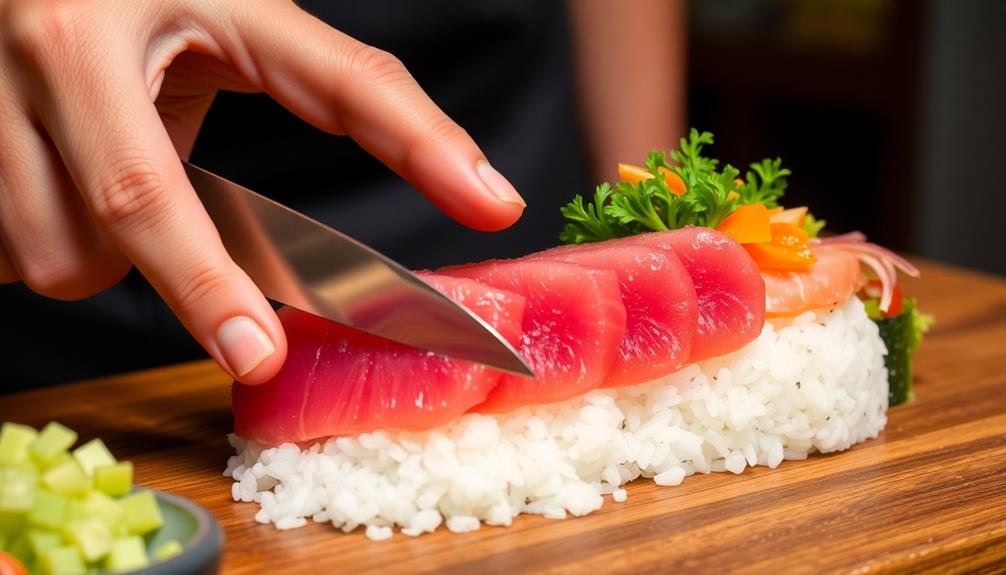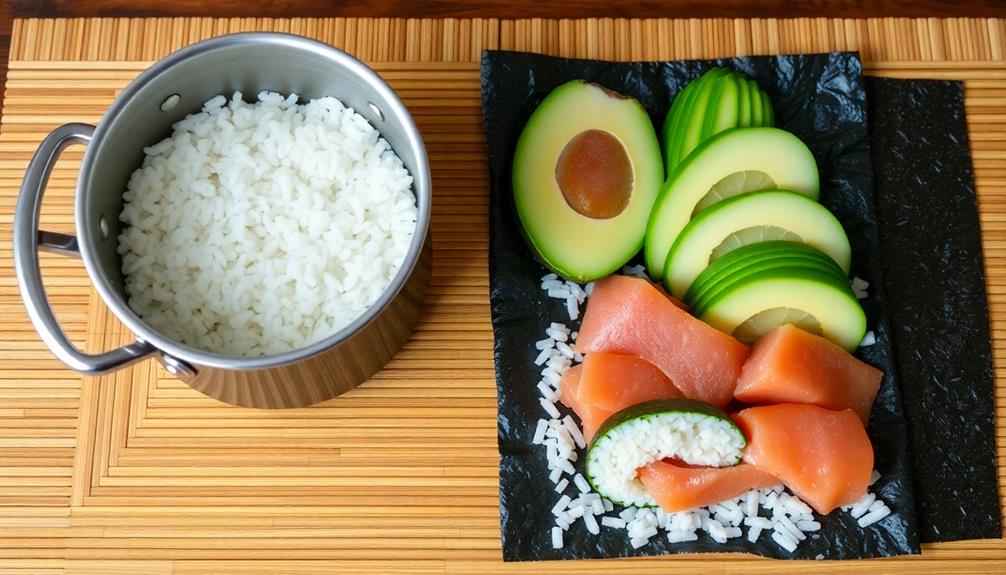Bring the mouthwatering flavors of Japan into your own kitchen! Sushi's roots trace back centuries as fishermen preserved fresh catches through fermentation and rice. Today, sushi chefs have refined techniques to craft bite-sized delicacies like nigiri and maki rolls. To make authentic sushi at home, start with high-quality sushi rice, then slice fresh fish and roll it all up using a bamboo mat. Don't forget the soy sauce and wasabi – these classic condiments will complete your sushi experience. With a little practice, you'll be an expert sushi chef in no time. If you want to dive deeper into the art of sushi-making, keep reading for detailed steps.
Key Takeaways
- Use high-quality short-grain sushi rice and properly season it with rice vinegar, sugar, and salt for the ideal texture and flavor.
- Slice fresh, high-quality fish, such as tuna, salmon, or yellowtail, into thin, even pieces for optimal presentation and texture.
- Utilize a bamboo mat to neatly roll sushi, arranging fillings and then sealing the roll with a moisture-dampened nori sheet.
- Garnish the sushi rolls with sesame seeds, applying a gentle outward rolling motion to help them adhere to the rice.
- Serve the sushi with soy sauce and wasabi for a traditional accompaniment that enhances the overall flavor experience.
History

Sushi's origins can be traced back to ancient times, when Japanese fishermen preserved their catches by fermenting them with rice. This early form of sushi, called narezushi, eventually evolved into the bite-sized delicacy we enjoy today.
Over the centuries, sushi chefs refined their techniques, developing new styles and presentations. From the delicate nigiri to the vibrant maki rolls, each sushi variety reflects the creativity and artistry of its makers.
As sushi spread beyond Japan, it captured the world's imagination. People were captivated by the delicate balance of flavors and the precision required to craft these edible works of art.
Today, sushi remains a beloved culinary tradition, enjoyed by people of all ages and backgrounds. Whether you're a sushi connoisseur or a curious newcomer, the history of this iconic dish is sure to inspire your own sushi-making adventures.
Recipe

Sushi-making at home can be a fun and satisfying culinary adventure. By following a few simple steps, you can create restaurant-quality sushi rolls in the comfort of your own kitchen. The key is to start with high-quality ingredients and pay attention to the details.
Sushi rice is the foundation of a successful sushi roll. To get it just right, you'll need to properly cook and season the rice, ensuring the perfect balance of sweetness, acidity, and stickiness. Once you have your rice prepared, the rest of the process is all about careful assembly and technique.
Ingredients:
- 2 cups short-grain white rice
- 1/4 cup rice vinegar
- 2 tablespoons sugar
- 1 teaspoon salt
- 8 sheets of nori (seaweed sheets)
- Assorted fillings (e.g., cucumber, avocado, cooked shrimp, crab meat, thinly sliced vegetables)
Instructions:
Cook the rice according to package instructions, then transfer it to a large bowl. Add the rice vinegar, sugar, and salt, and gently mix until the rice is well seasoned and the sugar has dissolved. Allow the rice to cool to room temperature.
Lay a sheet of nori on a bamboo sushi mat or a clean, flat surface. Spread a thin layer of the prepared sushi rice over the nori, leaving a 1-inch border at the top. Arrange your desired fillings in a horizontal line across the center of the rice. Carefully roll the sushi, using the bamboo mat or your hands to shape it into a tight cylinder. Repeat with the remaining ingredients to make additional rolls.
When making sushi at home, don't be afraid to experiment with different flavor combinations and fillings. The beauty of homemade sushi is that you can customize it to your own tastes.
Remember to keep your knife and hands wet when cutting the rolls, and use a sharp, serrated knife for clean, even slices. With a little practice, you'll be rolling up delicious sushi creations in no time.
Cooking Steps

Start by preparing your sushi rice according to the recipe, ensuring you achieve the perfect sticky consistency which is crucial for rolling.
Next, carefully slice your fresh, high-quality fish into thin pieces, as precision in cutting enhances the overall presentation and flavor.
Then, use a bamboo mat to neatly roll your sushi, making sure to garnish with sesame seeds.
Don't forget to serve your homemade sushi with soy sauce and wasabi on the side.
For an optimal viewing experience while enjoying your sushi, consider the role of color accuracy in home cinema projectors to enhance your movie nights.
Step 1. Prepare Sushi Rice

Preparing the sushi rice is a crucial step in the sushi-making process. Start by rinsing the short-grain rice in a fine-mesh strainer until the water runs clear. This removes excess starch and helps the rice achieve the perfect texture.
Next, combine the rice and water in a pot and bring it to a boil. Once boiling, reduce the heat to low, cover, and simmer for about 15 minutes. Remove the pot from the heat and let the rice sit, covered, for another 10 minutes.
In a large bowl, combine the cooked rice, rice vinegar, sugar, and salt. Using a wooden spoon or rice paddle, gently fold the ingredients together until the rice is evenly seasoned. Be careful not to overmix, as this can make the rice sticky.
Once the rice has cooled to room temperature, it's ready to be used in your sushi rolls or nigiri. With the right sushi rice, you're well on your way to creating authentic-tasting sushi at home.
Step 2. Slice Fresh, High-Quality Fish

With the sushi rice ready, you can now focus on selecting and slicing the fresh, high-quality fish needed for your sushi.
Start by visiting your local seafood market or grocery store and speaking with the fishmonger. Explain that you're making sushi at home and ask for their recommendations on the best fish to use. Popular options include tuna, salmon, yellowtail, and halibut.
Once you've chosen your fish, it's time to slice it properly. Using a very sharp, thin knife, carefully slice the fish into thin, even pieces, about 1/4 inch thick.
For nigiri sushi, the slices should be long enough to drape over the rice. When slicing, keep your knife at a slight diagonal angle and use a gentle, smooth motion to avoid tearing the delicate fish.
Remember to handle the fish gently, as you don't want to bruise or damage the delicate texture.
With your high-quality fish sliced, you're well on your way to creating authentic, delicious sushi at home.
Step 3. Roll Sushi With Bamboo Mat

Once you have your sushi rice and sliced fish ready, you can begin rolling your sushi using a bamboo mat.
Place the shiny side of the mat face down and lay a nori sheet on top, shiny side down. Spread a thin, even layer of sushi rice over the nori, leaving a small gap at the top. Arrange your sliced fish and other fillings in a line across the center of the rice.
Gently lift the bottom of the bamboo mat and begin rolling it away from you, tucking the nori tightly around the fillings as you go. Apply a bit of pressure to create a compact roll.
When you reach the top, use a damp finger to moisten the exposed nori, then continue rolling to seal the sushi. Use a sharp knife to slice the roll into 6-8 pieces, wiping the blade clean between cuts.
Repeat the process to create your desired number of sushi rolls.
Step 4. Garnish Sushi Rolls With Sesame Seeds

To garnish your sushi rolls with sesame seeds, first give the roll a gentle, outward rolling motion using your bamboo mat. This will help the seeds adhere evenly to the surface.
Grab a small handful of sesame seeds and sprinkle them generously over the roll, making sure they cover the entire surface. You can use a mix of white and black sesame seeds for an eye-catching contrast. Gently press the seeds into the rice using your fingertips, applying just enough pressure to make them stick without crushing the roll.
Next, use a sharp knife to slice the roll into bite-sized pieces. Make clean, even cuts and wipe the blade between slices to prevent the rice from sticking.
Arrange the sushi pieces on a serving plate, allowing the sesame seeds to shine. You can garnish the plate with additional toppings like pickled ginger or wasabi if desired.
Serve your beautifully garnished sushi rolls immediately, and enjoy the nutty, savory flavors of the sesame seeds in every delicious bite.
Step 5. Serve Sushi With Soy Sauce, Wasabi

Arrange your freshly sliced sushi rolls on a serving plate. It's time to add the perfect accompaniments – soy sauce and wasabi. The salty, umami-rich soy sauce complements the fresh flavors of the sushi, while the spicy, pungent wasabi adds a kick to each bite.
Start by placing small dishes of soy sauce and wasabi next to your sushi platter. Encourage your guests to add a dab of wasabi to their soy sauce, then dip their sushi pieces into the mixture. The combination of flavors will tantalize their taste buds.
Don't be afraid to use a generous amount of wasabi. The heat from the wasabi helps to cleanse the palate, allowing you to fully enjoy the nuanced flavors of the fish and rice. Experiment with the ratio of soy sauce to wasabi until you find the perfect balance for your personal preferences.
Serve the sushi with chopsticks, so your guests can easily pick up each piece and enjoy the full experience. With the right condiments, your homemade sushi is sure to impress.
Final Thoughts

Making sushi at home can be a rewarding and enjoyable experience. You've learned how to prepare the rice, slice the fish, and assemble the rolls.
Now, as you savor your homemade sushi, you can feel a sense of accomplishment. Sushi-making is an art form, and with practice, you'll continue to improve your skills.
Remember, the key to great sushi is using the freshest, highest-quality ingredients you can find.
Don't be afraid to experiment with different fillings and techniques. The more you make sushi, the more confident you'll become.
Sharing your sushi creations with friends and family can also be a fun way to celebrate your culinary achievements.
Sushi-making is a skill that can impress and delight your loved ones.
Frequently Asked Questions
What Equipment Do I Need to Make Sushi at Home?
To make sushi at home, you'll need a bamboo mat, a sharp knife, a rice cooker, sushi rice, nori sheets, and various fillings like fresh fish, vegetables, and condiments. Having the right equipment makes the process easier and more enjoyable.
How Long Does It Take to Prepare Sushi at Home?
Preparing sushi at home can take anywhere from 30 minutes to an hour, depending on your experience level. The time it takes can vary based on the complexity of the rolls you're making and your familiarity with the process.
Can I Use Regular Rice Instead of Sushi Rice?
You can use regular rice, but sushi rice is ideal. It has a distinct flavor, texture, and stickiness that regular rice lacks, which is essential for making authentic-tasting sushi at home.
How Do I Store Leftover Sushi?
To store leftover sushi, wrap it tightly in plastic wrap and refrigerate it. It'll keep for up to 2 days, but the rice may dry out. For best results, enjoy your sushi fresh on the day you make it.
What Type of Fish Is Best for Homemade Sushi?
For homemade sushi, you'll want to use the freshest, highest-quality fish you can find. Sashimi-grade tuna, salmon, and yellowtail are excellent choices that'll provide a delicious, authentic sushi experience. Just be sure to handle the fish properly to maintain its freshness.










